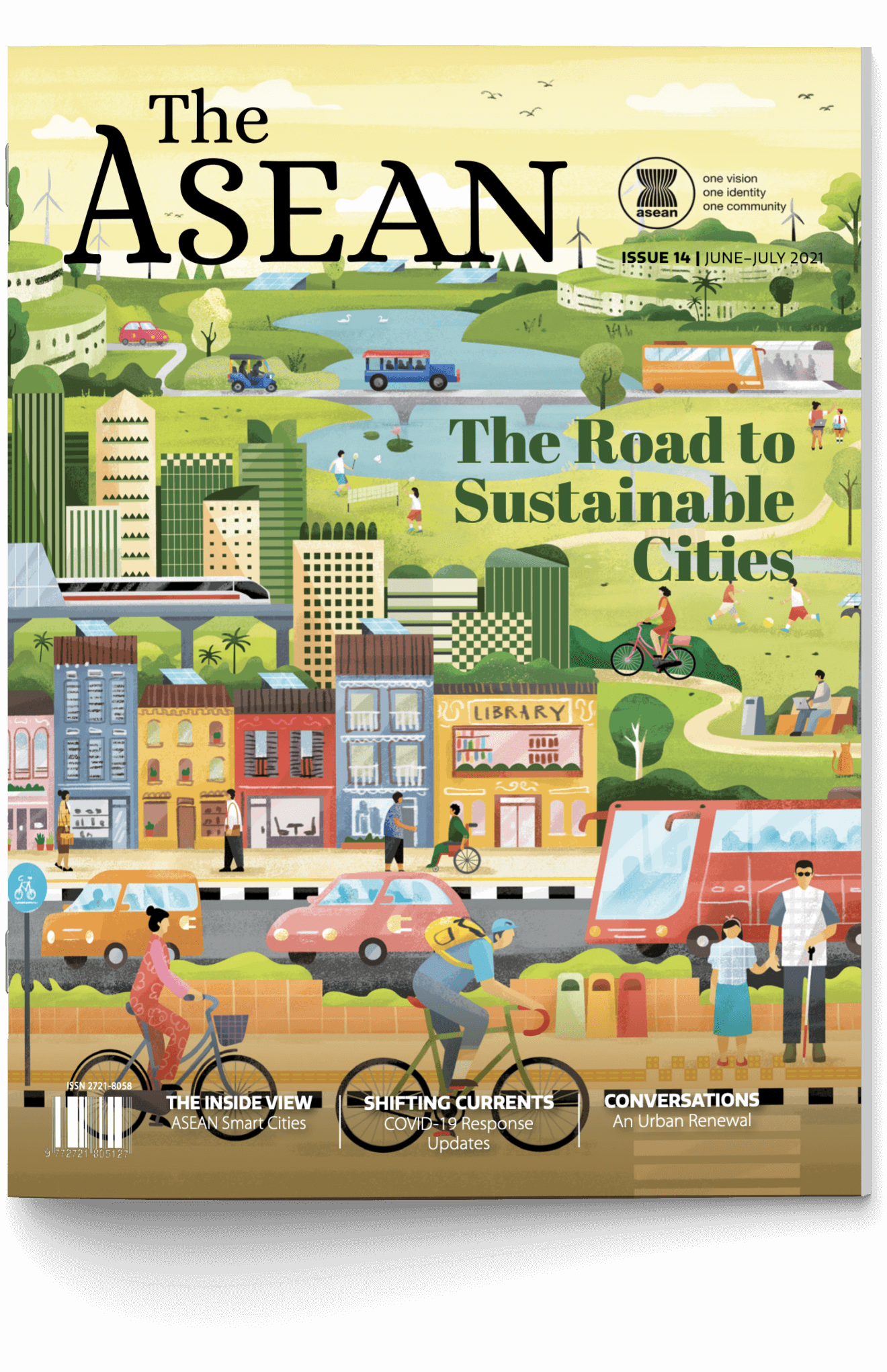

Subscribe to our newsletter:

Issue 14
June-July 2021
The Road to Sustainable Cities
Inside this Edition
Themes

8 Jul 2021
Sustainable and Smart Cities
Promoting Smart and Sustainable Urbanisation in ASEAN: Progress and Challenges
Cities are at the frontline of key global trends and challenges affecting the region, from pandemic to climate change and digitalisation to inclusive growth. Around half of ASEAN’s people already live in urban areas, and by 2025, a further 70 million people in this region will be city dwellers. Rapid urbanisation would place increasing pressures on most of these cities that may not be adequately equipped to deal with a growing range of potential threats.

24 Jul 2021
Environment, Sustainable and Smart Cities
Shaping Smarter ASEAN Cities: The Path Towards Environmentally Sustainable Cities
The last few decades saw the dramatic expansion of megacities in Southeast Asia. The region has one of the fastest growing rates of urbanisation, with more than half of its residents living in urban areas.

24 Jul 2021
Environment, Sustainable and Smart Cities
Confronting Urban Transport Woes in Southeast Asia
The COVID-19 pandemic may have restricted mobility for most of us who live in ASEAN’s bustling cities, but the reality is we still have to travel within our city’s confines using private or public transport. We sleep and wake up to inescapable sounds of vehicles rumbling by. We go about our lives inhaling air pollutants spewed by a constant stream of vehicles plying our streets.

24 Jul 2021
ASEAN Identity and Community Building, Culture
Building Greater Understanding and Tolerance in a Troubled World
We live in a troubled world of cultural pessimism where greater understanding and tolerance are becoming somewhat elusive. Worldwide, conflicts are getting longer and more complex, with some lasting 20 years on average.

24 Jul 2021
Culture
The Land of Gold, Spices and Coconuts: India’s Voyage to Southeast Asia
The monsoon winds that blew trading ships from India to Southeast Asia over the centuries also ushered in a deep cultural relationship that has continued until today. The maritime route began at either the Coromandel coast or the coast of the Bay of Bengal and continued to Cape Comorin and Straits of Malacca to reach the Malay Peninsula. There was also a land route via Bengal, Assam, Manipur, and Burma (now Myanmar) that reached different parts of Southeast Asia.

24 Jul 2021
Culture
Understanding India’s Ties to Southeast Asia through Literature
Novels that delve into the rich and colourful ties between India and Southeast Asia are still nascent. Here, The ASEAN is delighted to introduce two literary treasures written by two talented Indian authors. They created compelling fictional characters who navigated real-world events which took them from India to Malaysia, Myanmar, and Singapore—opening our eyes to forgotten histories and diverse cultures and perspectives.

24 Jul 2021
Culture
The Beats of Indian-Southeast Asian Tunes
Indian music is a reflection of the rich cultural traditions and history of India. Its unique sounds have created legions of fans around the world and influenced the global music scene.

8 Sep 2022
Environment, Poverty Alleviation, Sustainable and Smart Cities
Capturing the Urban Opportunity in Southeast Asia
Executive Director Maimunah Mohd Sharif shares with The ASEAN how good urban governance is crucial to ensure urbanisation leads to equitable and sustainable growth.
Interviews

8 Jul 2021
ASEAN Identity and Community Building, Environment
Dato Lim Jock Hoi
ASEAN Secretary-General Dato Lim Jock Hoi talks to The ASEAN on the qualities and benefits of smart cities, as well as the ongoing initiatives to support the region’s 26 major cities in developing, updating, and implementing their smart city action plans under the ASEAN Smart Cities Network initiative.

24 Jul 2021
Environment, Health and COVID-19, Sustainable and Smart Cities
Hugh Lim
Hugh Lim, Executive Director of Centre for Liveable Cities, weighs in on what it takes to build pandemic-proof and resilient cities based on the practices that worked and deficiencies that emerged during the COVID-19 pandemic. He discusses the benefits of transforming Southeast Asian cities into smart cities, particularly the role that smart solutions play in accelerating post-pandemic recovery and ensuring urban resilience to future crises.

24 Jul 2021
Digital Transformation, Sustainable and Smart Cities
Non Arkaraprasertkul, PhD
Dr. Non A serves in the Smart City Promotion Department of Thailand’s Digital Economy Promotion Agency, where he advocates the concept and practice of smart cities. He specialises in the use of human-centred design to solve pressing open-ended problems. Having lived and worked overseas, he is constantly inspired by design, qualitative research, and behavioural economics. Originally trained as an architect, he holds a doctorate in anthropology from Harvard University. Dr. Non A talks to The ASEAN
Conversations

24 Jul 2021
Environment, Sustainable and Smart Cities
Kotchakorn Voraakhom
Kotchakorn Voraakhom is on a mission to save her hometown, Bangkok, from the worst of environmental degradation. Armed with a master’s degree in landscape architecture from Harvard University in the United States, Kotch established a landscape architecture firm, Landprocess, to pursue her aesthetic goal of blending modern design with natural systems. She also founded Porous City Network, a social enterprise that focuses on addressing urban environmental problems in cities across Southeast Asia b

24 Jul 2021
Digital Transformation, Food Security and Nutrition
Muhammad Agung Saputra
Agung founded Surplus, an app that enables food retailers to sell their overstock or imperfect products to help limit food waste in Indonesia. Indonesia is the second-largest producer of food waste per capita in the world, producing around 23-48 million tons of food waste per year. This amount of food can feed 61 to 125 million people. Food loss and waste also contribute to around 7.29 per cent of Indonesia’s average greenhouse gas emissions and correspond to 213 to 551 trillion Indonesian rupia

24 Jul 2021
Environment, Food Security and Nutrition
Han Jing Toh
Seeing massive amounts of fresh produce thrown away in Singapore’s wet markets motivated Han Jing to help reduce food waste. She started composting seven years ago, when she was still a student at Nanyang Technological University. Family and friends soon followed suit, composting and reducing their own food waste. Han Jing also grows her own food and promotes native edible plants and sustainable soil farming. She teaches others how to “grow consciously, cook consciously, and trash consciously” t

24 Jul 2021
Environment, Food Security and Nutrition, Sustainable and Smart Cities
Bjorn Low
Bjorn took a leap of faith after 10 years of working in the digital marketing industry to explore a more sustainable lifestyle. His decision led him to a soul-searching journey across the United Kingdom, Spain, and Japan, where he learned to grow food in organic agricultural farms. When Bjorn returned home, he found underutilised spaces and incorporated urban farms into Singapore’s cityscape. In 2012, he co-founded Edible Garden City with the goal of improving sustainability in local food produc


